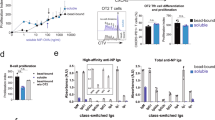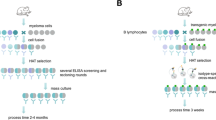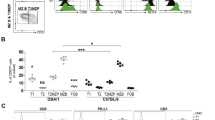Abstract
SELECTION and propagation of a single antibody-forming cell clone has been effected by serial transfer of limited numbers of spleen cells into irradiated syngeneic mice1. Original spleen cell donors were immunized with DNP conjugated to bovine gamma globulin (BGG). A single clone was identified by its characteristic secreted antibody to DNP. Sera of recipient mice were analysed by isoelectric focusing on polyacrylamide gels, and specific antibody molecules were visualized by 131I-hapten binding and autoradiography2. Using the antibody isoelectric spectrum as a phenotypic marker, we were able to follow one clone of anti-DNP forming cells (E9) through successive transfer generations; at the time of our first report1, clone E9 had been propagated through five transplant generations.
This is a preview of subscription content, access via your institution
Access options
Subscribe to this journal
Receive 51 print issues and online access
$199.00 per year
only $3.90 per issue
Buy this article
- Purchase on Springer Link
- Instant access to full article PDF
Prices may be subject to local taxes which are calculated during checkout
Similar content being viewed by others
References
Askonas, B. A., Williamson, A. R., and Wright, B. E. G., Proc. US Nat. Acad. Sci., 67, 1398 (1970).
Williamson, A. R., Europ. J. Immunol., 1, 390 (1971).
Askonas, B. A., and Williamson, A. R., Nature, 238, 339 (1972).
Mitchison, N. A., Europ. J. Immunol., 1, 10 (1971).
Makinodan, T., and Peterson, W. J., Proc. US Nat. Acad. Sci., 48, 234 (1962).
Wigzell, H., and Stjernsward, J., J. Nat. Cancer Inst., 37, 513 (1966).
Kishimoto, S., Tsuyugachi, I., and Yamamura, Y., Clin. Exp. Immunol., 5, 525 (1969).
Miller, J. F. A. P., and Mitchell, G. F., Transplant. Rev., 1, 3 (1969).
Mitchison, N. A., Rajewsky, K., and Taylor, R. B., Developmental Aspects of Antibody Formation and Structure (edit. by Sterzl, J., and Riha, I.) (Academic Press, New York, 1970).
Taylor, R. B., Transplant. Rev., 1, 114 (1969).
Martin, G. M., Sprague, C. A., and Epstein, E. J., Lab. Invest., 23, 86 (1970).
Cunningham, A. J., Austral. J. Exp. Biol. Med. Sci., 47, 485 (1969).
Hayflick, L., Exp. Cell Res., 37, 614 (1965).
Sado, T., Perkins, E. H., and Makinodan, T., J. Immunol., 105, 642 (1970).
Matioli, G., Vogt, H., and Niewisch, H., J. Cell Physiol., 72, 229 (1969).
Cunningham, A. J., Immunology, 16, 621 (1969).
Daniel, C. W., and Young, L. J. T., Exp. Cell Res., 65, 27 (1971).
Author information
Authors and Affiliations
Rights and permissions
About this article
Cite this article
WILLIAMSON, A., ASKONAS, B. Senescence of an Antibody-forming Cell Clone. Nature 238, 337–339 (1972). https://doi.org/10.1038/238337a0
Received:
Issue Date:
DOI: https://doi.org/10.1038/238337a0
This article is cited by
-
Cellular aging, in vitro and in vivo
Aging Clinical and Experimental Research (1993)
-
Cytogerontology since 1881: A reappraisal of August Weismann and a review of modern progress
Human Genetics (1982)
-
Immunology and aging
Experientia (1981)
Comments
By submitting a comment you agree to abide by our Terms and Community Guidelines. If you find something abusive or that does not comply with our terms or guidelines please flag it as inappropriate.



